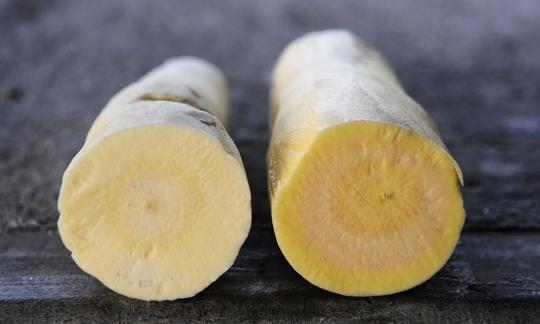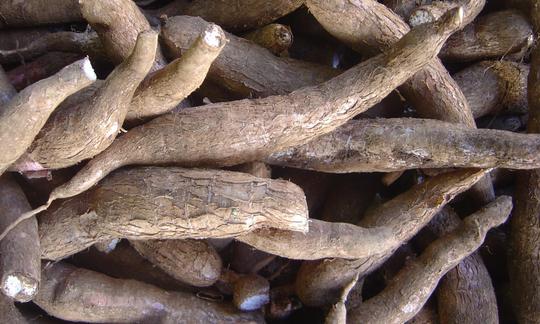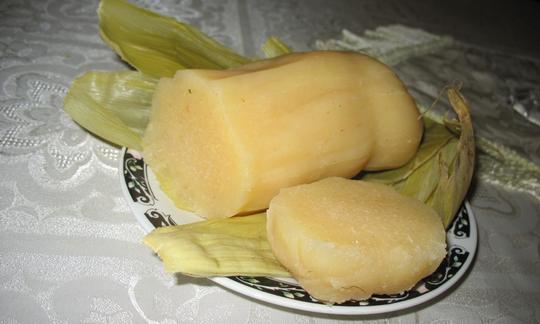Table of contents
Manioc ( Manihot esculenta ), also called cassava or yuca , is a crop from South America, the root tuber of which is mainly eaten. The tubers are poisonous when raw and are therefore only used when heated.
Using cassava in the kitchen:
The white flesh of the cassava tuber tastes neutral, bitter or sweet, depending on the variety. Is cassava poisonous? Can you eat cassava raw? It is important to know that the root tubers are poisonous when raw - so they are extremely unsuitable as a raw food. This danger can be avoided by squeezing, washing and heating.
In the countries of origin of cassava, it is part of the daily diet. How do you eat cassava? This South American root vegetable can be prepared in a similar way to potatoes : peeled and then roasted, baked, deep-fried or boiled. How do you eat cooked cassava? Cooked, it can be served as a vegetable side dish like boiled potatoes. Boiled and fried cassava strips are extremely popular as an alternative to potato fries. Cassava can also be made into a puree, porridge or mash - a famous African porridge recipe is fufu, which is made from cassava (or yam ) and plantains and is often eaten with peanut sauce. Mashed tubers can be formed into balls with a little coriander and salt and put on a salad, for example. Baked or deep-fried cassava slices also taste excellent and can be eaten like chips. You can also make a delicious curry with cassava, sweet potatoes , plantains or many other ingredients.
A flour can be obtained from the cassava root that can be used instead of wheat flour in all kinds of recipes, e.g. for bread, flatbreads, cookies and cakes. In Brazil, it is used to make beijú (small cakes that look like crêpes or pancakes) and farofa (roasted cassava flour (e.g. with onions , garlic , bananas , nuts, herbs), which is often served as a side dish with dishes such as bean stew). The starch obtained from cassava is called tapioca starch. This can be found in the form of small tapioca balls (sago) and can be used to thicken and bind sauces or desserts.
Cassava is also used to make alcoholic beverages such as taruba or kashiri. In addition to the tubers, the leaves of the cassava plant are also edible. The protein-rich cassava leaves can be eaten as a cooked vegetable.
Vegan recipe for cassava mash with vegetables:
Ingredients (for 2 people): 800 g cassava (raw, organic if possible), 4 spring onions , 4 stalks of celery , 1 red bell pepper , 1 red onion , 1 red chili pepper , 1 lime , 2 tbsp rapeseed oil , ½ bunch of coriander, 1 tsp achiote powder (also called annatto powder), a little salt.
Preparation: Peel the cassava, cut into cubes and cook in boiling, lightly salted water for about 20 minutes. Meanwhile, rinse the spring onions and cut into rings. Wash the celery and cut into bite-sized strips. Rinse the sweet pepper, remove the seeds and cut into large cubes. Peel the onion and cut into strips. Rinse the chili and cut into it with a knife. Halve the lime and squeeze out the juice. Fry the spring onions, celery, sweet pepper, onion and chili pepper with rapeseed oil in a heated pan for about 4 minutes. Add a little salt and season with fresh lime juice. Rinse the coriander, shake dry and chop finely. When the cassava has finished cooking, drain the water and roughly mash the cassava pieces with achiote powder. Place the cassava mash on a plate and serve with fried vegetables. Garnish the vegan dish with coriander and serve.
Vegan recipes with cassava can be found under the note: " Recipes that have the most of this ingredient ".
| Not only vegans or vegetarians should read this: Vegans often eat unhealthily. Avoidable nutritional mistakes . |
Shopping - where to buy?
Only large and well-stocked branches of a few supermarkets (e.g. Coop , Migros , Rewe , Edeka ) offer cassava tubers and cassava products. Many supermarkets (e.g. Denner , Volg , Spar , Aldi , Lidl , Hofer ) do not offer the exotic root tuber or processed products from it. In organic supermarkets (e.g. Alnatura , Denn's Biomarkt ) you only occasionally find cassava tubers or their products. In South American, Asian or African shops, on the other hand, cassava products are more common. Otherwise, you can buy cassava in online shops.
Found in the wild:
Populations of wild cassava ( Manihot esculenta subsp. flabellifolia ) occur mainly in west-central Brazil and eastern Peru. This wild subspecies is found in forest patches in the transition zone between the cerrado vegetation (savanna scrub) and the lowland rainforest of the Amazon basin, where it grows as a climbing shrub or sapling in the undergrowth. 1
Storage:
Whole cassava tubers should be stored unrefrigerated in a dry, dark place. The tubers spoil quickly, so they should be used up quickly. If they have been cut, they should be used within 3-4 days, but faster if possible. Signs of spoilage are blue-black spots and a soft consistency.
Cassava: Ingredients - Nutritional values - Calories:
The energy content of cassava (raw) is 160 kcal per 100 g. The majority of the calories come from carbohydrates (38 g/100g). Raw cassava is low in fat with 0.28 g fat per 100 g, but also rather low in protein with 1.4 g protein per 100 g. Black salsify (1.4 g/100g) and celeriac (1.5 g/100g) have comparable protein contents. Potatoes , on the other hand, are slightly richer in protein (2 g/100g). 2
The vitamin C content is 21 mg/100g (26% of the daily requirement). Potatoes (20 mg/100g) and yam beans (20 mg/100g) contain a similar amount. Yellow bell peppers contain almost nine times as much vitamin C at 184 mg/100g. 2
100 g of raw cassava also contains 0.38 mg of manganese , which makes up 19% of the daily requirement. Yams (0.4 mg/100g), black salsify (0.41 mg/100g) and corn cobs (0.36 mg/100g) contain similar amounts. Significantly more manganese can be found in pine nuts (8.8 mg/100g). 2
Cassava (raw) contains 27 µg folate per 100 g (14% of the daily requirement), which is comparable to fennel (27 µg/100g). Edamame contains particularly high levels of folate, with 303 µg per 100 g. 2
The complete ingredients of cassava, the coverage of the daily requirement and comparison values with other ingredients can be found in our nutrient tables. In the article Nutrients explained you will get a detailed insight into the topic.
Health aspects - effects:
Is cassava healthy? Cassava flour is gluten-free and is therefore a good alternative to wheat flour and products made from it for people who suffer from celiac disease (gluten intolerance). Due to its easy digestibility and high energy content, the root tuber is particularly recommended for digestive problems (helps with excess gastric acid, gastritis, duodenal ulcers and colon inflammation), liver diseases and during convalescence as the first solid food after a serious illness or operation. 3
According to a study, it is also possible that cassava could counteract the development of obesity and thus diabetes due to its lower fat content compared to wheat . 4
Dangers - Intolerances - Side effects:
Cassava contains cyanogenic glucosides (plant poisons) such as linamarin and lotaustralin. The toxic hydrocyanic acid (HCN) released by cyanogenic glucosides through the enzyme linase - which is released when the tuber is injured - can, if consumed inappropriately or over a long period of time, contribute to the development of neurological disorders such as motor impairment, cognitive deterioration and symptoms characteristic of tropical ataxic neuropathy and endemic spastic paraparesis (konzo). 5 Heating inactivates the linase enzyme and therefore the release of hydrocyanic acid. 6 How toxic is cassava? 40 mg of hydrocyanic acid per 100 g of fresh weight can be fatal for an adult. Some cassava cultivars contain such doses when raw. 6 It is therefore very important to heat the cassava tuber sufficiently. What should I do if I eat cassava raw? If you eat raw cassava, you should consult a doctor immediately.
The cassava tuber is a rich source of carbohydrates but poor in vitamins and proteins. It is a staple food in many tropical developing countries. The low protein content of the root tuber can lead to protein-energy malnutrition (PEU; formerly protein-energy malnutrition) in people living in areas where the diet is predominantly cassava-based. In some regions, the slightly higher protein cassava leaves are used as a dietary supplement to increase protein intake. Another approach to increasing cassava nutrients and thereby reducing the severity of PEU is to breed cassava with improved protein content using biotechnology tools. 7
Use as a medicinal plant:
The cassava root is also important as a medicinal plant. Fresh root tubers help as a poultice in the treatment of ulcers. The cassava seeds of some varieties also have a laxative and emetic effect. 8
Occurrence - Origin:
Cassava ( Manihot esculenta ) probably comes from the western Amazon region. It was probably the indigenous population that cultivated the plant around 5,000-7,000 years ago. After the arrival of the Europeans in South America, Portuguese traders brought cassava to Africa and Asia, where it became well established in tropical areas. Today, cassava is grown on around 26.3 million hectares worldwide in the tropics, with an average yield of 11 tons of tubers per hectare. 9 Along with corn , sugar cane and rice, cassava is one of the most important energy suppliers in the diet of most tropical countries in the world. 10
The origin of today's cassava cultivar is not entirely clear. However, several studies assume that it originates from the wild relative Manihot esculenta subsp. flabellifolia . 10,11
Cultivation - Harvest:
Cassava is mainly grown in regions between 30 degrees south and 30 degrees north latitude. It is generally found where the average temperature is above 20 °C. The annual rainfall for cultivation is best at more than 1000 mm, but the plants can also grow in areas with rainfall of 650 to 750 mm spread over just five months. Permeable soil that prevents waterlogging is necessary for cassava plants. The plants are also particularly adapted to soils with low fertility. 9
Cassava is a robust crop that can cope well with extreme weather conditions and could therefore become more important in view of climate change. 9 However, its cultivation is subject to some restrictions, such as pests and diseases. Two viral diseases of particular concern are cassava mosaic disease and brown streak disease, which can threaten entire harvests, especially in Africa. 11
General information:
What is cassava? The cassava plant ( Manihot esculenta ) is a shrub and belongs to the spurge family (Euphorbiaceae). Except for a few species, all spurge plants contain the poisonous milky sap that serves as wound closure and protection against being eaten.
Alternative names:
Other names for manioc are cassava, Kassava, Kassave, Mandioca, Mandioka, Yuca and Yucca. Since manioc is eaten as often in tropical areas as potatoes are in many European countries, it has been given the colloquial name tropical potato. Incorrect spellings such as Manjok, Manipk, Manoik, Maeok, Manjoka, Manjoc creep in.
In English, the terms cassava and manioc are predominant.
Key words on the use of cassava:
Cassava is used in the animal feed industry in the form of pellets for animal feed. In addition to being used as food and animal feed, the root tubers are also used to produce bioethanol. 10 Furthermore, biodegradable bags can be made from cassava as a plastic alternative. 12












Comments